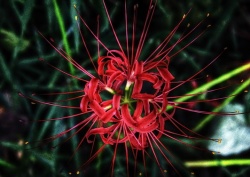Difference between revisions of "Pawos"
Jump to navigation
Jump to search
| Line 1: | Line 1: | ||
[[File:121006 Manjusaka.jpg|thumb|250px|]] | [[File:121006 Manjusaka.jpg|thumb|250px|]] | ||
| − | ::{{Nolinking|dpa' bo redirects here and it can also refer to '''[[Arya Shura]]''' (Skt. ''[[Ārya Śūra]]''; Tib. {{BigTibetan|[[དཔའ་བོ་]]}}, [[Wyl.]] ''[[dpa' bo]]'')}} | + | ::{{Nolinking|[[dpa' bo]] redirects here and it can also refer to '''[[Arya Shura]]''' (Skt. ''[[Ārya Śūra]]''; Tib. {{BigTibetan|[[དཔའ་བོ་]]}}, [[Wyl.]] ''[[dpa' bo]]'')}} |
-----------<br/><br/> | -----------<br/><br/> | ||
Latest revision as of 03:22, 17 August 2014
In Vajrayana Buddhism, Pawo (Wylie: dpa' bo; literally "brave guy") is translated "hero" or "warrior". Depending on context, it can refer to the ideal of a Vajrayana practitioner; to living people (where it is sometimes used as an honorific or part of a name); to legendary or mythical figures from the past; or to purely spiritual beings.
"Pawo" translates the Sanskrit terms daka and vira, with similar meaning.
Pawos are typically described in consort with khandros, their feminine counterparts.
The tülku Nenang Pawo is often known simply as Pawo Rinpoche.
The concept plays a central role in Chögyam Trungpa's Shambhala terma, where "pawo" is translated "warrior".
